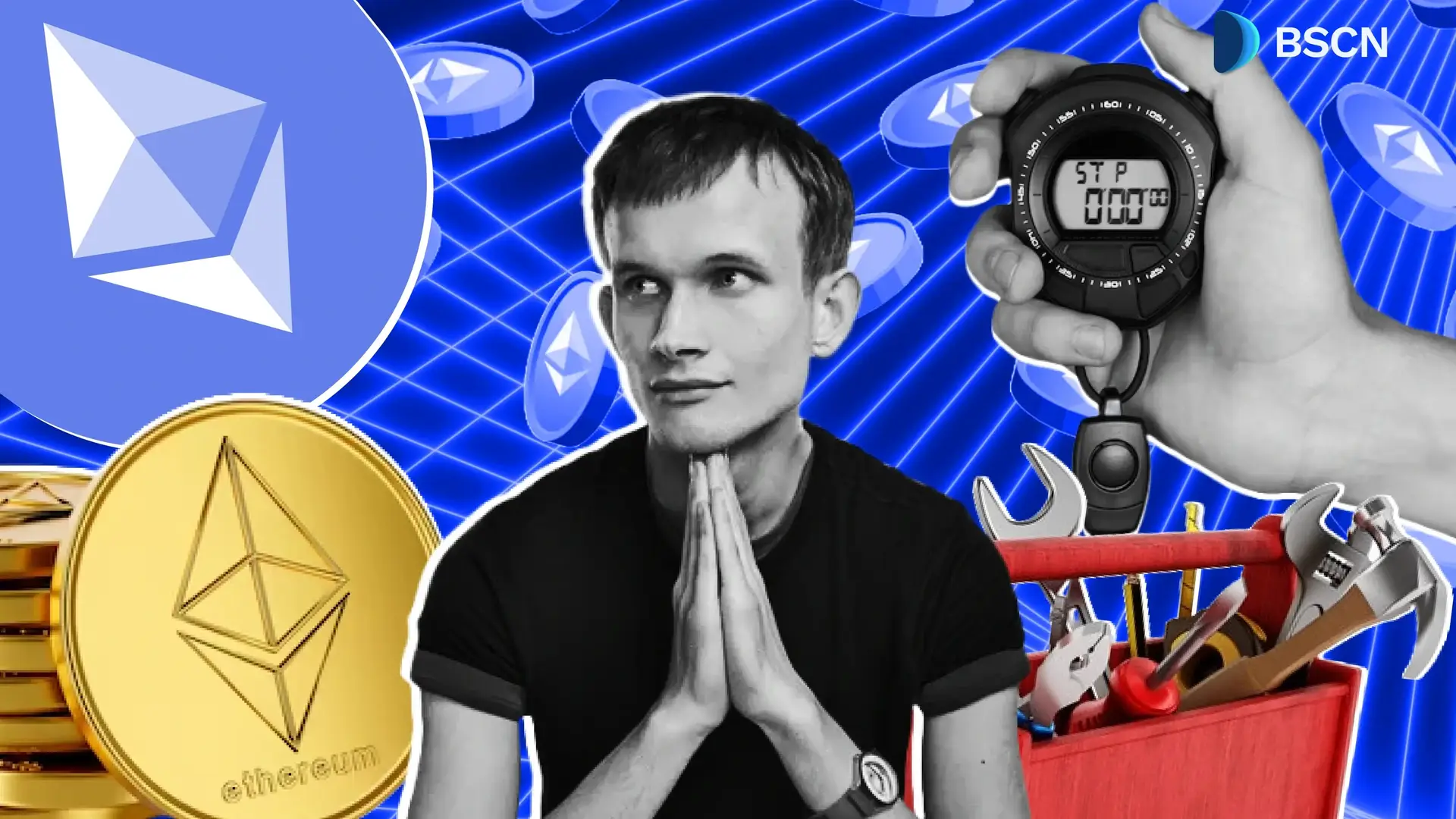News
(Advertisement)
Vitalik Buterin Proposes Radical Overhaul for Ethereum by Replacing EVM

Buterin argues that Ethereum must take drastic steps to remain competitive with faster, cheaper blockchains.
Soumen Datta
April 21, 2025
(Advertisement)
Table of Contents
Ethereum, the world's second-largest cryptocurrency by market capitalization, has long been at the forefront of blockchain innovation. However, the network has faced growing challenges regarding scalability, transaction costs, and performance.
Vitalik Buterin, Ethereum's co-founder, recently proposed a significant change to Ethereum’s underlying structure, suggesting the replacement of its existing Ethereum Virtual Machine (EVM) with the RISC-V instruction set architecture. This bold move aims to boost Ethereum’s speed, lower costs, and keep the network competitive in the fast-evolving blockchain space.

What is RISC-V and Why It Matters for Ethereum
RISC-V (pronounced "Risk Five") is an open-source, free processor architecture that is gaining traction in the technology world due to its efficiency and flexibility. Unlike proprietary processor architectures like ARM or x86, RISC-V is open and customizable, making it a powerful tool for developers who want to optimize hardware and software for specific applications.
Buterin’s proposal is rooted in the belief that adopting RISC-V could significantly enhance Ethereum’s execution layer, providing a more efficient way to process transactions and smart contracts. Buterin argues that RISC-V's architecture could help Ethereum scale by slashing execution costs up to 100 times in certain cases.
A Radical Proposal to Improve Ethereum’s Execution Layer
Buterin's proposal, set for potential implementation by April 2025, aims to replace the current EVM contract language with upgradeable RISC-V instruction sets. He identifies several bottlenecks in the Ethereum network’s execution layer, including the efficiency of the EVM proving process and the limitations in transaction speed. To address these challenges, Buterin proposes the adoption of RISC-V, which he believes could offer significant performance improvements.
One key benefit of RISC-V is its ability to simplify Ethereum’s execution layer. The Ethereum community has long struggled with scaling issues, particularly around transaction speed and cost. By integrating RISC-V, Ethereum could improve its throughput, making the network faster and more cost-efficient.
The Economic Pressure on Ethereum
Ethereum has faced increasing economic pressure as transaction fees—the network’s primary revenue source—have declined significantly.
For the week ending March 30, Ethereum blob fees totaled only 3.18 ETH—approximately $5,000—representing 95% decline since mid-March.
📊 Ethereum by the Numbers
— etherscan.eth (@etherscan) April 1, 2025
🗓 Mar 24 - 30
Ethereum recorded its lowest weekly blob fees so far this year pic.twitter.com/hxfu9H3AXf
In April 2025, the average transaction fee on the Ethereum base layer fell to just $0.16 per transaction, the lowest level since 2020. This decline in fees is largely due to the rise of layer-2 solutions like Arbitrum and Optimism, which offer cheaper and faster transaction processing by operating off-chain.
While these layer-2 solutions have provided relief for Ethereum’s scalability issues, they have also undermined the revenue of the base layer. As users migrate to these cheaper alternatives, Ethereum’s core network faces diminishing returns. The reduction in revenue generation, paired with waning investor confidence, has led to concerns that Ethereum may struggle to stay financially viable in the long term.
RISC-V and Ethereum’s Future Competition
Buterin's proposal to adopt RISC-V is also driven by the increasing competition from newer, faster blockchains like Solana and Sui. These networks offer minimal transaction delays and high throughput, enticing developers and users alike. Ethereum, despite its historical dominance, is at risk of falling behind if it doesn’t innovate and adapt to the demands of the market.
RISC-V adoption could help Ethereum stay competitive by enabling faster transaction processing and reducing costs. This could attract more users to the platform, both for basic transactions and complex decentralized applications (dApps). However, the implementation of such a radical change comes with its own set of challenges.
Challenges of Redesigning the Execution Layer
While many in the Ethereum community have praised Buterin’s vision, the proposal has sparked concerns among some developers. Rebuilding Ethereum's execution layer from the ground up would be a massive undertaking, requiring significant resources and time.
The task of ensuring backward compatibility with existing contracts could also pose challenges, as the current system would need to work seamlessly alongside the new RISC-V system.
Moreover, some fear that the redesign could introduce new vulnerabilities into the network, potentially compromising Ethereum’s security. The complexity of integrating RISC-V into Ethereum’s existing infrastructure may also lead to unforeseen complications, which could delay the rollout of new features or upgrades.
Despite these challenges, there are those who see RISC-V as a necessary step to future-proof Ethereum.
A New Chapter for Ethereum?
Buterin’s RISC-V proposal could mark a pivotal moment in Ethereum’s history. The integration of RISC-V could reduce costs, increase transaction speed, and make Ethereum more competitive with newer blockchains like Solana and Sui.
The proposal also raises broader questions about the future of Ethereum. The ability of Ethereum to innovate and remain relevant will become increasingly important as layer-2 solutions continue to grow in popularity and next-generation blockchains attract more attention. By embracing new technologies like RISC-V, Ethereum may be able to continue its dominance as the leading smart contract blockchain.
However, the path forward is not without risks. The Ethereum community will need to carefully consider the trade-offs involved in implementing such a drastic change. With Buterin's proposal, Ethereum could enter a new era of innovation and adapt to new challenges, ensuring its leadership in the blockchain space.
Read Next...
Disclaimer
Disclaimer: The views expressed in this article do not necessarily represent the views of BSCN. The information provided in this article is for educational and entertainment purposes only and should not be construed as investment advice, or advice of any kind. BSCN assumes no responsibility for any investment decisions made based on the information provided in this article. If you believe that the article should be amended, please reach out to the BSCN team by emailing [email protected].
Author
 Soumen Datta
Soumen DattaSoumen has been a crypto researcher since 2020 and holds a master’s in Physics. His writing and research has been published by publications such as CryptoSlate and DailyCoin, as well as BSCN. His areas of focus include Bitcoin, DeFi, and high-potential altcoins like Ethereum, Solana, XRP, and Chainlink. He combines analytical depth with journalistic clarity to deliver insights for both newcomers and seasoned crypto readers.
(Advertisement)
Latest News
(Advertisement)
Crypto Project & Token Reviews
Project & Token Reviews
Comprehensive reviews of crypto's most interesting projects and assets
Learn about the hottest projects & tokens














